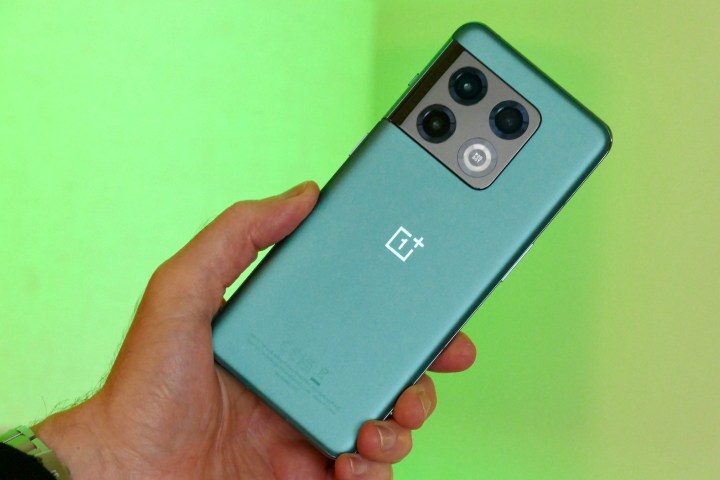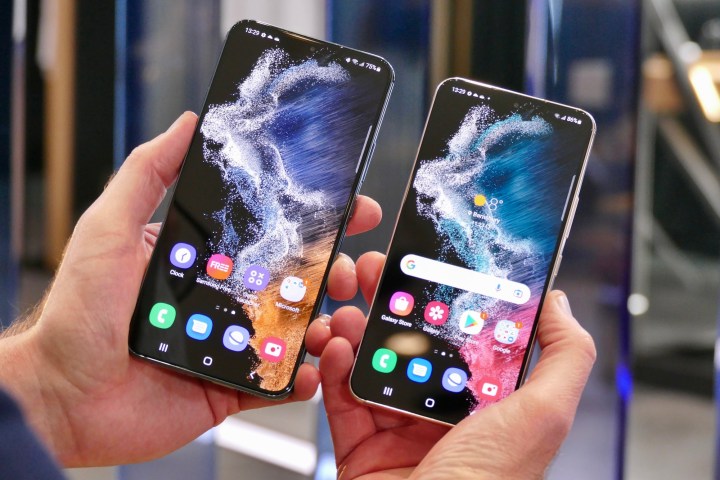Fresh from a merger with Oppo, OnePlus has released its flagship smartphone for 2022, the OnePlus 10 Pro. It features a rejigged new design, but aside from incorporating elements of Oppo’s ColorOS, it largely continues in the tradition of previous OnePlus models. This means it treats users to a large, beautiful screen, a versatile camera, very fast charging, and reliably quick performance. As a “Pro” model, it positions itself as a premium flagship, yet with no OnePlus 10 on the horizon, it also finds itself in competition with “standard” devices such as the iPhone 13.
How does it compare to the latter? Well, we find this out in a OnePlus 10 Pro versus
Specs
| OnePlus 10 Pro | iPhone 13 | |
| Size | 163 x 73.9 x 8.6mm (6.42 x 2.91 x 0.34 inches) | 146.7 x 71.5 x 7.7mm (5.78 x 2.81 x 0.30 inches) |
| Weight | 201 grams (7.09 ounces) | 174 grams (6.14 ounces) |
| Screen size | 6.7-inch Fluid AMOLED (120Hz) | 6.1-inch Super Retina OLED |
| Screen resolution | 3216 x 1440 pixels (525 pixels per inch) | 2532 x 1170 pixels (460 ppi) |
| Operating system | Android 12, OxygenOS 12.1 | iOS 15 |
| Storage | 128GB, 256GB, 512GB | 128GB, 256GB, 512GB |
| MicroSD card slot | No | No |
| Tap-to-pay services | Google Pay | Apple Pay |
| Processor | Qualcomm Snapdragon 8 Gen 1 | Apple A15 Bionic |
| RAM | 8GB/12GB | 4GB |
| Camera | 48-megapixel wide, 50MP ultrawide, 8MP telephoto rear, 32MP front | Dual-lens 12MP wide and 12MP ultrawide rear, 12MP TrueDepth front |
| Video | 8K at 24 frames per second, 4K at 120 fps, 1080p at 240 fps | 4K at up to 60 fps, 1080p at 240 fps |
| Bluetooth version | Bluetooth 5.2 | Bluetooth 5.0 |
| Ports | USB-C, 3.1 | Lightning connector |
| Fingerprint sensor | Yes, in-display | No, FaceID instead |
| Water resistance | IP68 | IP68 |
| Battery | 5,00mAh
Fast charging (65W U.S.A., 80W international) Fast wireless charging (50W) |
3,240mAh Fast charging (20W charger sold separately) MagSafe wireless charging (15W)Qi wireless charging (7.5W) |
| App marketplace | Google Play Store | Apple App Store |
| Network support | T-Mobile | All major carriers |
| Colors | Volcanic Black, Emerald Forest, Panda White (Extreme Edition) | Black, blue, green, white, and red |
| Prices | $899+ | $799+ |
| Review score | 4 stars out of 5 | 4.5 stars out of 5 |
Design, display, and durability

The OnePlus 10 Pro has much the same edge-to-edge display as previous models, yet its rear benefits from something of a refurbishment. The camera module has been rejigged to have a nice 2×2 squarish form, while its panel fits snugly to the rest of the phone. It looks distinctive yet also discreet, providing the kind of sophistication you’d want from a phone costing at least $899.
With the
While preferences as to design are arguably a matter of taste, the OnePlus 10 Pro definitely has a better display. Its 6.7-inch Fluid AMOLED screen contains 3216 x 1440 pixels, which works out at 525 ppi. The
On the other hand, there’s no doubt that the iPhone is more durable than the OnePlus 10 Pro. It carries an IP68 rating, indicating the ability to withstand immersion in up to 1.5 meters of water for half an hour. Unfortunately, the OnePlus carries no such rating, so even though it does boast a superior display, the lack of durability puts this round back in the balance.
Winner: Tie
Performance, Battery Life, and Charging

The OnePlus 10 Pro runs off the Qualcomm Snapdragon 8 Gen 1, which is manufactured using a 4nm process, meaning it’s faster than earlier chips that used 5nm or 7nm transistors. The
It’s kind of a similar story with the batteries of each phone. The
However, what sets the OnePlus ahead is that it enables fast charging at either 65W (if you’re in the United States) or 80W (if you live anywhere else). This means you can go from, say, 40% to 100% in around 15 minutes. This kind of convenience isn’t something the iPhone can match, so while the two phones are otherwise closely matched, this round goes to OnePlus’ device.
Winner: OnePlus 10 Pro
Cameras

The OnePlus 10 Pro has three cameras: A 48MP main camera, an 8MP camera for telephoto scenarios, and a 50MP ultrawide lens. By contrast, the
Sure, the 12MP main and 12MP ultrawide lenses on the iPhone may be comparatively small. Nevertheless, thanks to a combination of sensor-shift OIS (optical image stabilization) and dual pixel PDAF (phase-detection autofocus), as well as Apple’s software prowess, the photos taken by both lenses are almost always well-balanced, colorful, and pleasingly dynamic. The same can largely be said for the OnePlus 10 Pro’s main
To some extent, OnePlus’s inclusion of an interesting 150-degree ultrawide mode does make it a versatile and quirky camera phone. The thing is, when it comes to the fundamentals, the
Winner: Apple iPhone 13
Software and Updates

The OnePlus 10 Pro ships with
With the
The same goes for updates. This is despite the fact that OnePlus guarantees three years of core software updates for the 10 Pro. This is pretty good by
Winner: Apple iPhone 13
Special Features

Both phones support
Other than that, the OnePlus arguably has a few more special features than the
Winner: Tie
Price and availability
The OnePlus 10 Pro starts at $899 and can be ordered from OnePlus. It’s supported by T-Mobile in the U.S. and will be widely available through third-party electronics retailers.
The
Overall winner: iPhone 13
There’s no mistaking that the OnePlus 10 Pro is a solid all-around phone, but the iPhone 13 beats it in just enough areas to take home a clear win. Its more consistent camera and software, as well as its longer-term support, are all big differences that put it ahead of the OnePlus device. Still, if you are an
Editors' Recommendations
- This is the iPhone concept of my dreams
- Best iPhone 15 deals: How to get Apple’s latest iPhone for free
- I found an amazing new way to use my iPhone 15 Pro Max
- One of the most iconic iPhone accessories is back — and it’s great
- Are you having iPhone alarm problems? A fix is coming soon



